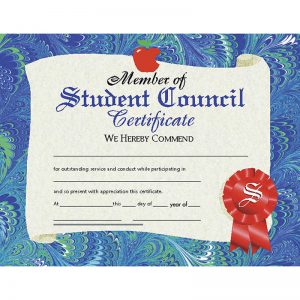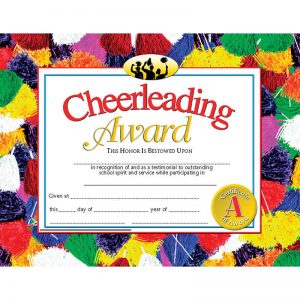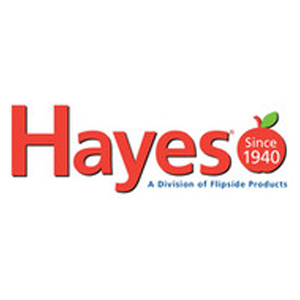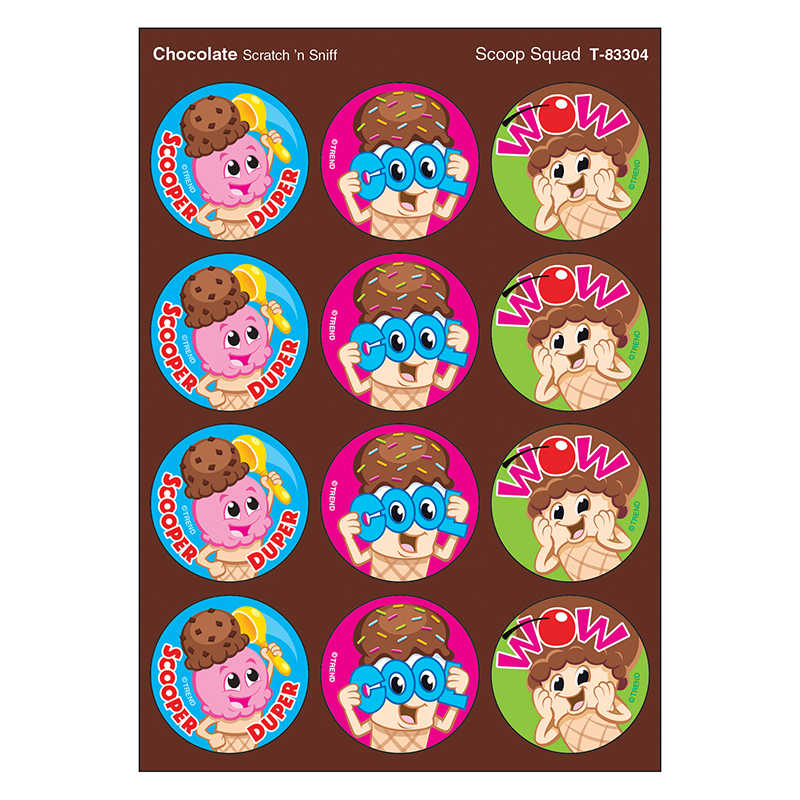Grade 4 Reading Comprehension Activities
WHAT IS A DESERT?
Many, many miles of the earth are covered by deserts. There are deserts on almost all of the continents, including North America. Deserts are hot, dry areas where little rain falls. In fact, to be called a desert, an area must have less than 10 inches of rain a year.
Because deserts are so hot and dry, few things can live there. Plants and animals need water. Sometimes it doesn’t rain in the desert for five years. Often water holes are 100 miles apart. This lack of water makes it hard for things to grow and live in the desert.
Deserts are also very hot. The temperature is often higher than 100 degrees. It can go as high as 135 degrees in the shade! Not many things can live in such a hot climate.
WORKSHEET & Sample PDF Activity
Sample PDF Activity
Underline the best answer for each question:
- To be called a desert, an area must have
a. hot weather
b. few living things
c. less than 10 inches of rain per year. - This article says that
a. nothing lives in the desert
b. few things grow there
c. few things live and grow in deserts. - From the article you can guess that plants and animals need
a. some dry air
b. water to live
c. more rain - Most plants and animals prefer
a. wet climates
b. trees
c. cooler and wetter climates
d. other continents - Underline the sentence in the story that gives the best answer to the question, “What is a desert?”
- Why do so few things live in the desert?
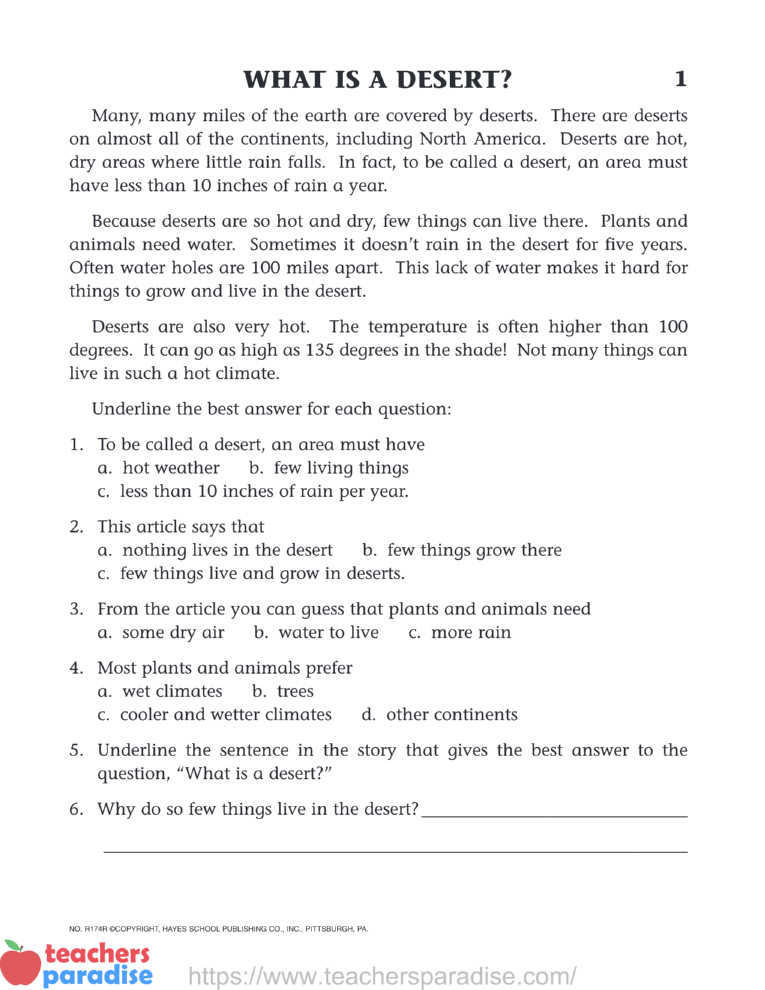
DESERT ANIMALS
Most animals find the desert a hard place in which to live, but there are many animals which have no trouble living there. These animals all have special ways of storing or getting water.
Some store extra water in their bodies. Camels can store enough water for seven or eight days. Desert turtles store water in special sacks under their shells. A certain type of desert frog can fill its body with water, much as you would fill a balloon with water. The frog can store a month’s supply. Desert ants store water in other ants! Certain worker ants have special bodies that hold extra water. They supply the water for the other desert ants who cannot store water. The worker ants are like water trucks on legs.
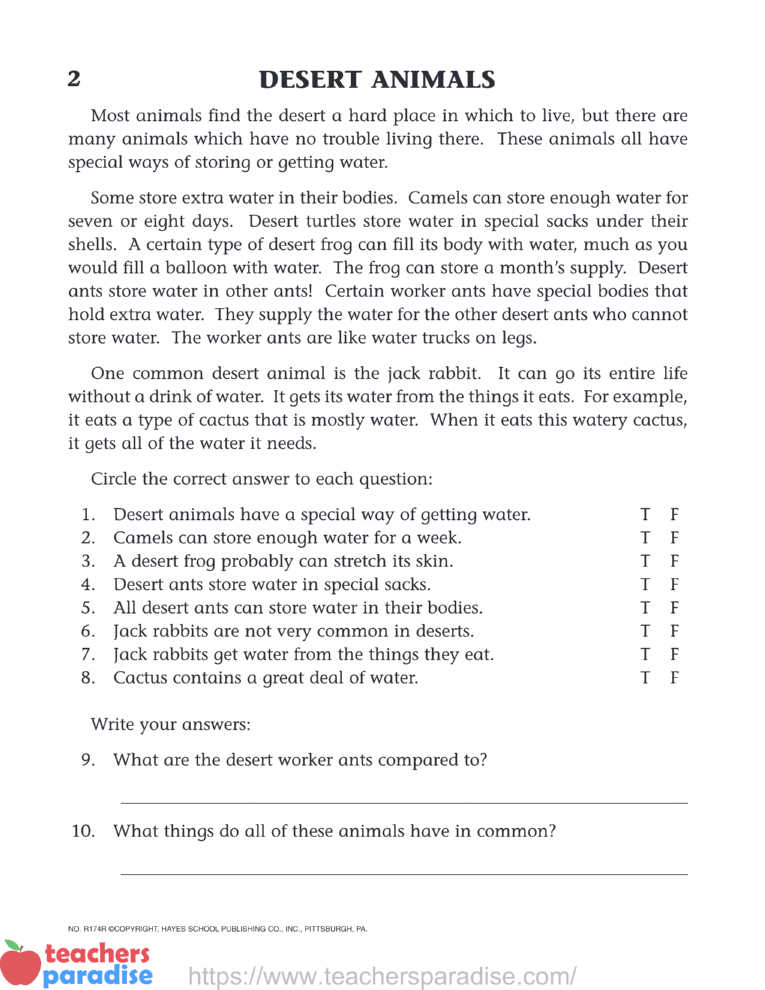
One common desert animal is the jack rabbit. It can go its entire life without a drink of water. It gets its water from the things it eats. For example, it eats a type of cactus that is mostly water. When it eats this watery cactus, it gets all of the water it needs.
Circle the correct answer to each question:
- Desert animals have a special way of getting water. T F
- Camels can store enough water for a week. T F
- A desert frog probably can stretch its skin. T F
- Desert ants store water in special sacks. T F
- All desert ants can store water in their bodies. T F
- Jack rabbits are not very common in deserts. T F
- Jack rabbits get water from the things they eat. T F
- Cactus contains a great deal of water. T F
Write your answers:
- What are the desert worker ants compared to?
- What things do all of these animals have in common?
ANSWER KEY
Page 1. What Is a Desert?
Skills Reinforced: Main Idea; Inference
Answers: 1. c; 2. c; 3. b; 4. c; 5. Deserts are hot, dry areas where little rain falls; 6. Answers will vary, but the important idea is that deserts are hot, dry, and have little water.
Table of Contents
What Is a Desert? (Main Idea/Inference) – 1
Desert Animals (Main Idea/Details/Inference) – 2
Desert Plants (Main Idea/Cause-Effect Relationships) – 3
Linda’s Graph (Reading Graphs) – 4
Ken’s Cable Car (Main Idea/Drawing Conclusions) – 5
Maggie the Movie Star (Main Idea/Emotional Reaction of Characters) – 6
Stubborn as Pea Soup? (Sentence Meaning/Context/Similes) – 7
Before and After (Sequence/Sentence Meaning) – 8
A True Story about a Mouse (Sequence/Paragraph Meaning) – 9
How to Make Ink (Main Idea/Sequence/Reading to Find Specific Information) – 10
Meet Joy Amoaka (Main Idea/Time Relationships) – 11
More about Joy Amoaka in Ghana (Main Idea/Details/Process) – 12
Joy Amoaka and the Stools (Main Idea/Drawing Conclusions) – 13
Here and There (Classifying/Inferences/Compare and Contrast) – 14
What’s in a Name? (Main Idea/Details/Drawing Conclusions) – 15
What Is a Dictionary Entry? (Dictionary Entry/Meaning/Context) – 16
You and Your Big Mouth (Main Idea/Supporting Details) – 17
What Is a Stomach? (Main Idea/Cause-Effect) – 18
Pussywillows and Tadpoles (Compound Words/Alphabetical Order/Sentence Meaning) – 19
A Compound Puzzle (Word Meaning/Compound Words/Following Directions) – 20
What Happens First? (Sentence Meaning/Time Relationships/Complex Sentences) – 21
Telescopes and Microscopes (Main Idea/Classifying/Inference) – 22
The South Street Fair (Bar Graph/Drawing Conclusions) – 23
Some Facts about the Planets (Main Idea/Supporting Details) – 24
Amazing Maria (Main Idea/Supporting Details/Outline Form) – 25
Pronunciation Key (Pronunciation Key) – 26
A Life of Pictures (Main Idea/Characterization) – 27
Is That You, Watson? (Main Idea/Predicting Outcomes) – 28
Sticks and Stones (Characterization/Emotional Reactions) – 29
Do Lift a Finger (Sentence Meaning/Idioms) – 30
Using an Encyclopedia (Encyclopedia/Alphabetical Order) – 31
More About Encyclopedias (Encyclopedia/Alphabetical Order) – 32
What Happens at a Fish Market? (Main Idea/Time Relationships/Sequence) – 33
Who Is in Charge Here? (Main Idea/Classifying/Details) -34
Is That a Fact? (Distinguishing Between Fact and Opinion) – 35
Meet Some of the Horse Family (Main Idea/Details/Drawing Conclusions) – 36
Rhyming Words (Rhymes/Context) – 37
What Does It Mean? (Word Meaning/Context Clues) – 38
Taking Words Apart (Prefixes/Sentence Meaning/Context) – 39
Helpful Hints (Suffix/Sentence Meaning/Context Clues) – 40
A Head Scratcher (Word Meaning/Prefix/Suffix) – 41
A Greek Myth (Main Idea/Literary Type) – 42, 43
Phaethon and the Sun God (Part I: Main Idea/Drawing Conclusions/Myth) – 44, 45
Phaethon Rides the Sun Chariot (Part II: Inference/Summarizing) – 46, 47
Jumping Stories (Main Idea/Distinguishing Between Fact and Fiction) – 48
Using a Dictionary (Dictionary Skills/Guide Words) – 49
A Smelling Trip (Main Idea/Inference) – 50
Nature’s Classroom (Reading to Find Specific Detail) – 51
Rain or Shine? (Details/Definitions/Context) – 52
Fast Freddie Writes Again (Sentence Meaning/Context/Homonyms) – 53
Anna Comes Home (Main Idea/Inference/Setting) – 54, 55
Word Parts (Word Parts/Meaning/Prefix) – 56
People Who Worked for Washington (Details/Classifying) – 57
Groups of People and Things (Classifying/Outline Form) – 58
In the Good Old Days (Using an Index) – 59
What Is an Aardvark? (Context/Word Meaning) – 60
Follow That Man! (Following Directions) – 61
Four-Eyes Harry (Main Idea/Empathy/Biography) – 62, 63
Where Would You Look? (Reference Books/Review) – 64

